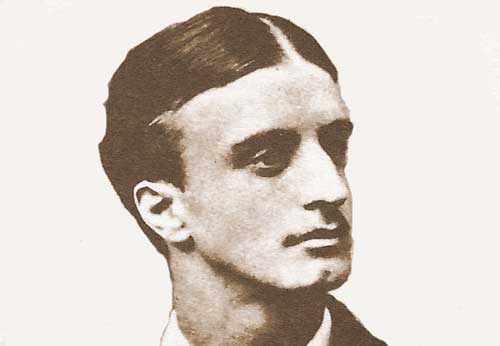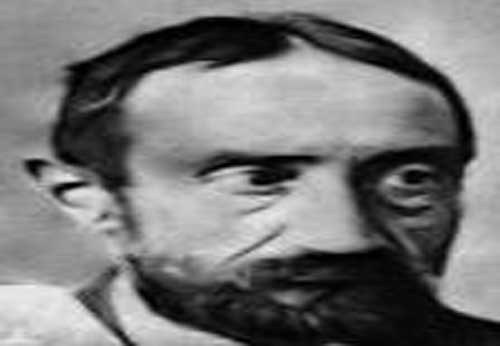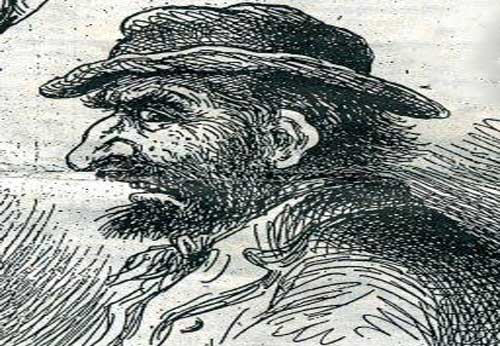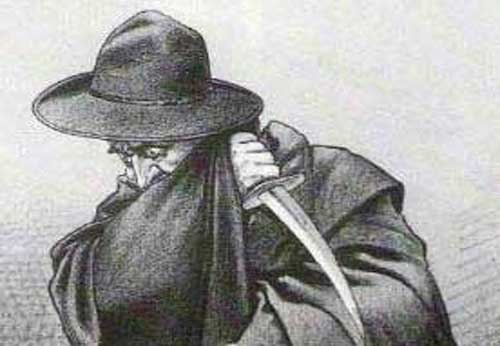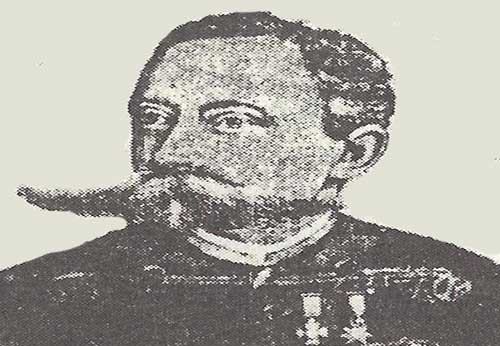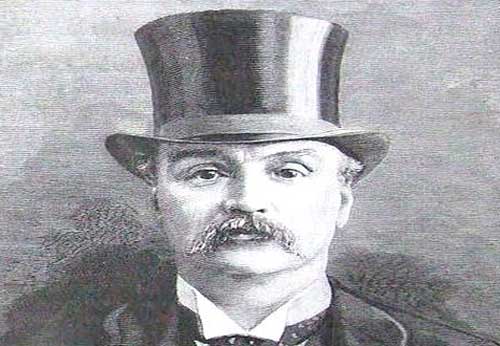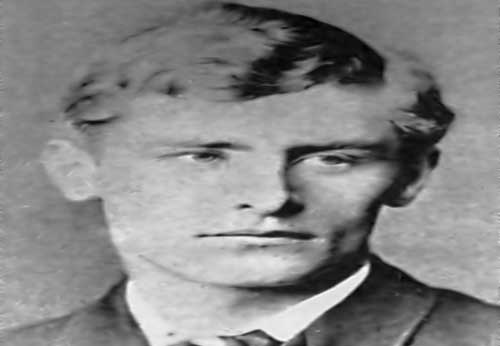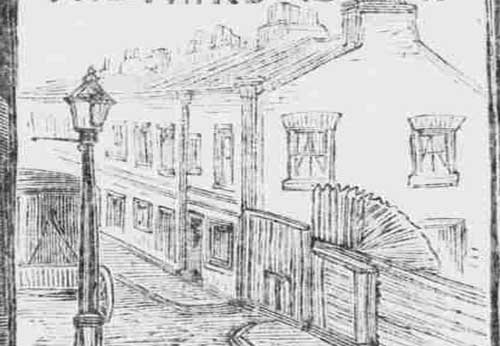- Charles Cross was the man who found the body of Jack the Ripper victim Mary Nichols at around 3.40am on August 31st, 1888.
- He was, in fact, on his way to work when he made his gruesome discovery in Buck's Row, Whitechapel.
- In recent years, however, his name has turned up on the ever growing list of Jack the Ripper suspects..
- Site Author and Publisher Richard Jones
- Richard Jones
CHARLES CROSS OR CHARLES LECHMERE
A KILLER BY ANY OTHER NAME
A CASE OF FINDERS, KILLERS
It can sometimes seem that the main criteria for a person to be placed on the ever growing list of Jack the Ripper suspects is for that person to have simply been in the area at the time of the murders, which, taken to its logical conclusions reduces the Jack the Riper suspect pool to a mere 67,000 or so people!
Actually, my previous statement is a little flippant since, for a suspect to be a viable one, you do have to place him in the area at the time of the crime and, ideally, you should be able to place him at the scene of the crime - which is the point at which the case against many Jack the Ripper suspects begins to fall horribly apart.
Such is the case with Charles Allen Lechmere or, to use the name that he is better known under - Charles Cross.
BORN IN SOHO
The man formerly known as Charles Cross was born in the parish of St Ann's, Soho in 1849.
His father was John Allen Lechmere, and his mother was Marie Louisa Lechmere.
Following her husband's death, Marie married Police Constable Thomas Cross, and, although Charles continued using the name Lechmere, he, for some reason, chose to give his name as Cross when he reported the fact that he had found the body of Mary Ann Nichols.
THE MAN WHO FOUND MARY NICHOLS
Just to recap briefly, Charles Cross was the local carman, or carter, (in modern day parlance a driver or porter or removals man) who, whilst on his way to work, at around 3.40am on August 31st 1888, passed along Buck's Row and had the misfortune to stumble upon the body of Mary Nichols - the woman who is generally accepted as having been the first victim of the killer who went on to become known as Jack the Ripper.
Or at least, that's the story he told the police and that's what he stated at the inquest into the death of Mary Nichols.
And, pretty convincing he must have been too, since the police, the Coroner (Wynne Baxter), the inquest Jury, the newspapers - not to mention the generations of amateur sleuths and Ripperologists down the years - have been content to accept his version of events.
The general consensus has always been that Cross had the misfortune to stumble upon the body of Jack the Ripper's fist victim as he made his way to work, and that there his involvement in the case ended.
NAMED AS A SUSPECT
However, in 2012, several newspapers carried articles claiming that, far from being an innocent bystander who had simply stumbled upon the body of Mary Nichols, Cross was, in fact, the man who had murdered her and that his subsequent statements were a tissue of lies aimed at throwing the police off his trail.
HE WAS CERTAINLY IN THE AREA
Now, I have to say, one of the points I often make when I lecture on the case to students, and they are setting about researching viable suspects, is that the main thing we must do, before anything else, is choose suspects who we can provably place in the area at the time of the murders.
In this respect, Charles Cross fits the bill perfectly.
Not only was he actually in the area at the time, but he was also walking towards the very location where the murder occurred, more or less at the exact time that the murder was being carried out.
So, there's a big tick in favour of his being a suspect.
HIS INQUEST TESTIMONY
This is how the Daily News reported his testimony at the inquest into Mary Nichols's death:-
Charles A. Cross, carman, said he had been in the employment of Messrs. Pickford and Co. for some years.
On Friday morning he left home about half past three to go to work, and passing through Buck's row he saw on the opposite side something lying against a gateway. In the dark he could not tell at first what it was. It looked like a tarpaulin sheet, but walking to the middle of the road he saw it was the figure of a woman.
At the same time he heard a man about forty yards away coming up Buck's row in the direction witness had himself come. He stepped back and waited for the newcomer, who started on one side, as if he feared that the witness meant to knock him down. The witness said, "Come and look over here. There's a woman."
They both went across to the body, and the witness took hold of the hands while the other man stopped over her head to look at her. The hands were cold and limp, and the witness said, "I believe she's dead." Then he touched her face, which felt warm. The other man placed his hand on her heart, saying, "I think she's breathing, but it's very little if she is." He suggested that they should "shift her," meaning in the witness's opinion that they should seat her upright. The witness replied, "I am not going to touch her." The woman's legs were uncovered. Her bonnet was off, but close to her head.
The witness did not notice that her throat was cut, as the night was very dark.
He and the other man left the deceased, and in Baker's row they saw Police Constable Mizen whom they told that a woman was lying in Buck's row. The witness added, "She looks to me either dead or drunk," and the other man remarked, "I think she's dead." The policeman answered, "All right."
The other man left witness soon afterwards. He appeared to be a carman, but the witness had never seen him before.
The Coroner: Did you see Police constable Neil in Buck's Row?
The Witness: No, sir. I saw no one after leaving home, except the man that overtook me, the constable in Baker's row, and the deceased. There was nobody in Buck's row when we left.
The Coroner: Did the other man tell you who he was?
The Witness: No, sir. He merely said that he would have fetched a policeman but he was behind time. I was behind time myself."
THE WITNESS WHO SAW HIM
The presumption has always been that Robert Paul, the second person to arrive at the scene of Mary Nichols's murder, arrived in Buck's Row shortly after Charles Cross had found her body.
But, according to those who favour Cross as a suspect, Paul actually interrupted Cross in the act of murdering Mary Nichols and, far from standing looking at the body, Cross was "trying to cover up some of the wounds" on the body that he himself had inflicted when Paul encountered him in Buck's Row.
The theory goes that, on hearing Robert Paul's approach, Cross had to think quickly and so, rather than flee the scene, and potentially draw suspicion to himself as the perpetrator, he chose instead to remain at the scene and feign shock.
According to a report in the Evening Standard, in its edition of the 3rd September, 1888, Robert Paul recalled what happened thus:-
It was exactly a quarter to four when I passed up Buck's-row to my work as a carman for Covent-garden market.
It was dark, and I was hurrying along, when I saw a man standing where the woman was.
He came a little towards me, but as I knew the dangerous character of the locality I tried to give him a wide berth. Few people like to come up and down here without being on their guard, for there are such terrible gangs about. There have been many knocked down and robbed at that spot.
The man, however, came towards me and said, 'Come and look at this woman."
I went and found the woman lying on her back. I laid hold of her wrist and found that she was dead and the hands cold. It was too dark to see the blood about her. I thought that she had been outraged, and had died in the struggle.
I was obliged to be punctual at my work, so I went on and told the other man I would send the first policeman I saw. I saw one in Church-row, just at the top of Buck's-row, who was going round calling people up, and I told him what I had seen, and I asked him to come, but he did not say whether he should come or not. He continued calling the people up, which I thought was a great shame, after I had told him the woman was dead.
The woman was so cold that she must have been dead some time, and either she had been lying there, left to die, or she must have been murdered somewhere else and carried there.
If she had been lying there long enough to get so cold as she was when I saw her, it shows that no policeman on the beat had been down there for a long time. If a policeman had been there he must have seen here, for she was plain enough to see. Her bonnet was lying about two feet from her head."
CROSS CONTRADICTED
Those who favour Cross as a suspect argue that Robert Paul's account was at odds with the one given by Charles Cross.
According to Cross, he had been walking along the opposite side of Buck's Row when he observed something lying in the gateway, and he had only gone as far as the "middle of the road" when he saw that, what was lying in the gateway was, in fact, "the figure of a woman."
He was, he said, still standing there when he heard Paul approaching.
However, according to Robert Paul, Cross was actually "standing where the woman was."
In other words, it may well have been that Cross had just murdered Mary Nichols when Robert Paul came along Buck's Row and interrupted him performing his gruesome deed.
THE EVIDENCE AGAINST HIM
So, if Charles Cross is a serious contender for the mantle of having been Jack the Ripper, then what other evidence is there that could seal his guilt and enable us to say, for goodness knows how the many-ith time "case closed"?
Well sadly, very little.
HE GAVE THE POLICE A FALSE NAME
One of the main points that arouses suspicion against him is that he gave the police a false name.
According to authors and researchers Christer Holmgren and Edward Stow, his name wasn't Charles Allen Cross, as he told the police and the inquest, but was, in fact, Charles Lechmere.
He would have only given a false name, so the theory goes, if he had something to hide - that something being that he was embarking upon a reign of terror which, over the coming weeks, would see him eviscerate the bodies of five local women as he made his way from his place of residence to his place of work.
However, if his motivation was to keep the police off his trail, the fact that he appears to have not only given the police his correct address and place of employment, but that he also appeared as a witness at the inquest into the death of Mary Nichols, means that he was either a cool and ruthless operator, or that he gave the false name for some other reason - one that can only be guessed at, given the fact that it appears to have not been spotted or commented on at the time.
HE WAS A LOCAL MAN
Another point put forward by the "Crossists" is that he was a local man, which many experts believe Jack the Ripper almost certainly was.
In fact, he lived only a few streets to the east of Buck's Row, at 22 Doveton Street, Bethnal Green, and he worked as a carman or cart driver for Pickford's in Broad Street, 30 or so minutes to the west of Buck's Row.
HIS ROUTE TO WORK
When he found the body of Mary Nichols he was on his way to his place of employment at the Pickford's depot in Broad Street, a journey that would have taken him around 40 minutes on foot and which would have taken him through the streets that were destined over the coming weeks to become the epicentre of Jack the Ripper's killing ground.
As the Daily Telegraph put it when, along with several other newspapers, it broke the story of his supposed guilt on the 31st August 2012:-
...all the subsequent murders took place between his home in Doveton Street, in Bethnal Green, and place of work in Broad Street at times when he would have been walking to work..."
Fair enough then. His route from home to work took him along the very streets where the murders occurred, he must have been Jack the Ripper!
BUT WHAT ABOUT ELIZABETH STRIDE?
Except, and I hate to be pedantic about this, Berner Street, where the murder of Elizabeth Stride took place, isn't, by any stretch of the imagination, on a logical trajectory from Doveton Street to Broad Street - unless that is, you wish to discount Elizabeth Stride as a victim of Jack the Ripper, as, admittedly, some researchers do.
However, the Cross/Lechmere-ists have an answer for this anomaly, arguing that his mother lived in Cable Street, to the south of Berner Street, and so he may have murdered Elizabeth Stride on his way to or from a visit to his mother's residence.
Evidently Charles Cross/Lechmere wasn't the type of man who could simply enjoy a leisurely stroll through the streets of Whitechapel without spicing his journey up with a spot of murderous mayhem en route.
WAS HE A MEAT DELIVERER?
Interestingly, there are suggestions that the Pickford's branch he worked at dealt with the delivery of meat and that, therefore, if he actually had blood stains on his hands or clothing, this fact would enable him explain their presence.
ANOTHER POSSIBLE LIE
It would also appear that, according to the later recollection of Police Constable Mizen, Cross lied to him by suggesting that there was already a policeman at the scene of the murder in Buck's Row.
Many newspapers quoted Mizen as telling the inquest that a carman, whom he identified as Cross when he was brought into the inquest room, had told him:- "You are wanted in Buck's row by a policeman; a woman is lying there." Why Cross, or Lechmere, would claim, if he did, that there was already a policeman at the scene, when this was demonstrably not the case, is something of a mystery.
However, several newspapers quoted Mizen's testimony as being that Cross's exact words to him were:- "You're wanted down there (pointing to Buck's Row)."
Although only slightly different, this latter statement puts a different slant on Cross's meaning, in that he may not have mentioned another policeman at all, but rather had simply informed Mizen that he was needed in Buck's Row where a murder had been committed. Mizen, on arriving at the scene to find Police Constable Neil already present, may have believed with hindsight that Cross may have meant that he was wanted by another policeman.
Obviously, with the passage of more than 130 years, it is now almost impossible to report accurately the exact exchange between the two in order to judge whether Cross lied, or whether different reporters simply interpreted Mizen's inquest testimony differently.
After all, if what Mizen testified was that Cross had said "you're wanted down there", meaning that he had best hurry to Buck's Row because he and Paul had discovered a woman's body there, a reporter observing the proceedings might have deduced that to mean that he [Mizen] was wanted by someone else - i.e. another policeman.
Another possibility is that Cross did indeed fib to cover up the callousness that both he and Paul had demonstrated by leaving the woman lying in the gateway, because they were already late for work.
WHAT HE TESTIFIED
Whatever his actual words to Mizen at the time, he was adamant at the inquest that he hadn't said anything about another policeman being at the crime scene when he was specifically asked about it by a member of the jury.
A Juryman: Did you tell Constable Mizen that another policeman wanted him in Buck's row?
The Witness: No; because I did not see a policeman in Buck's row."
Of course, it all hinges on Mizen's actually inquest testimony.
But, since the official transcripts of the inquest have not survived, we are dependent on the, often contradictory, press reports for any information we can glean.
CERTAINLY PRESENT AT ONE CRIME SCENE
It goes without saying that the ONLY crime scene we can actually place Cross/Lechmere at with any degree of certainty is the Mary Nichols one. His presence at all the others is pure conjecture and falls into the what if?, could have been, might have been, could have done, might have done school of Ripperology.
Here is an example:-
Martha Tabram was murdered on a route Cross could have taken to work at a time when he was in the area. Polly Nichols was murdered along his path and he was found near her body. Annie Chapman was murdered on the same route days later. If we knew with absolute certainty what time Chapman was killed the case for or against Cross would become clearer...The double event, the killings of Elizabeth Stride and Catharine Eddowes, could have been performed by Cross...The murders, so far, could have been done going to and from work. Does the killing of Mary Kelly fit this template or was it an adventurous change in the killer's modus operandi? Was it a holiday treat? A man who had got away with so much may have felt like experimenting..."
Here is another:-
...Eight days after Cross was discovered with the body of Nichols, another prostitute was murdered along one of his routes at a time when he was habitually (or could have been) in the vicinity... it is not impossible that Cross arrived at Pickford's at 4am and began his workday by driving to Spitalfields Market. His wagon may have been being loaded or unloaded nearby while he dealt with Chapman. No other suspect is so strongly linked to these three murders. Every day other men walked these streets at similar times, but only Charles Cross was discovered beside a body.
WAS HE JACK THE RIPPER?
So, was Charles Cross/Lechmere Jack the Ripper?
As with so many of the suspects, the honest answer has to be that he might have been.
However, this answer is based solely on the fact that, since we don't know who Jack the Ripper actually was, we can't dismiss or confirm any suspect with a 100 per cent certainty.
The evidence against Cross/Lechmere is, to say the least, circumstantial, consisting largely of the fact that the majority of the murders took place on his route to work and that he was found at the scene of one of the murders shortly after it had taken place.
Admittedly, the fact that he appears to have given a false name does arouse suspicion against him - and it would be interesting to know why this wasn't picked up on at the time - but he may have had another motive for this deception other than to hide the fact that he was a ruthless serial killer, who was murdering women on his way to work.
WAS CHARLES CROSS WAS JACK THE RIPPER?
David McNab, the producer of the Channel Five television documentary that examined the evidence, such as it is, against Charles Cross, who was quoted in the Daily Express as saying:-
The man who committed these crimes would have been a local. He would have been able to blend into the background and walk the streets without being detected.
Lechmere was discovered standing over the body, but bizarrely no one seemed to think that this was an important fact.
I am totally convinced that we have found Jack the Ripper."
Meanwhile, Edward Stow, one of the authors who favours the candidacy of Charles Cross/Lechmere, was quoted as saying:-
The police at the time were looking for some sort of special individual. But most crimes turn out to be someone quite ordinary. He [Cross] walked past every single murder scene on his way to work. He is the best suspect so far."
So, there you have it. Jack the Ripper could have been stopped almost before he had begun, if only the police had thought to take a closer look at Charles Cross, the ordinary nobody who, whilst walking to work throughout the early autumn mornings of 1888, couldn't resist the urge to indulge in a spot of murder and mutilation, and who blatantly lied about who he actually was.
If only the solution were that simple!
Article Sources
Evening Standard, 3rd September, 1888.
Daily Telegraph, 31st August, 2012.
Paul Begg, Martin Fido and Keith Skinner. The Jack the Ripper A to Z. Headline Book Publishing Plc. (1992)
Richard Jones. Uncovering Jack The Ripper's London. New Holland Publishing (2007)

